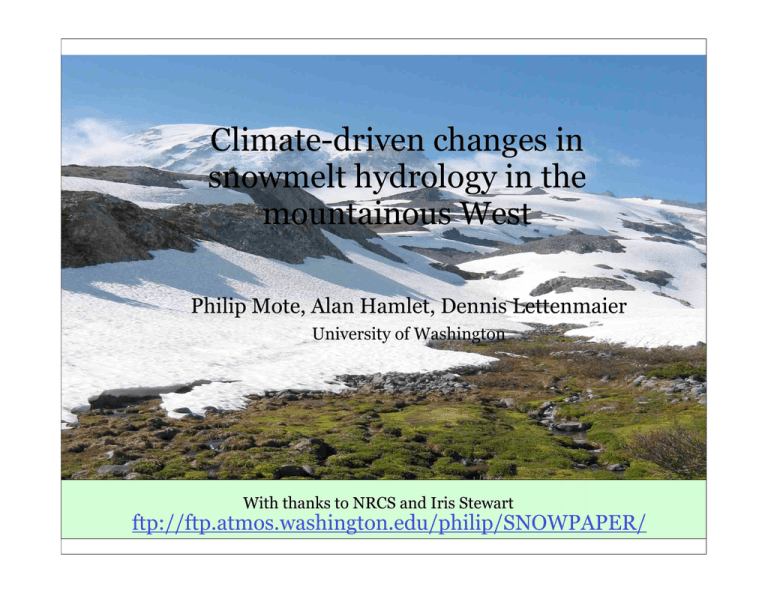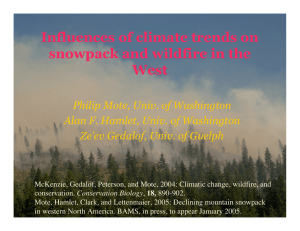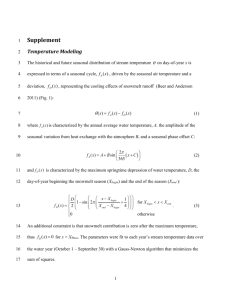Climate-driven changes in snowmelt hydrology in the mountainous West
advertisement

Climate-driven changes in snowmelt hydrology in the mountainous West Philip Mote, Alan Hamlet, Dennis Lettenmaier University of Washington With thanks to NRCS and Iris Stewart ftp://ftp.atmos.washington.edu/philip/SNOWPAPER/ Main point Over large areas and long times, the dominant influence on snowmelt hydrology is temperature, which has been inexorably increasing Warming has produced trends in • spring snow water equivalent (SWE), • spring snowmelt timing, • timing of peak SWE, • winter and spring runoff Schematic of VIC Hydrologic Model and Energy Balance Snow Model PN W GB CA Snow Model CR B VIC simulation •! 1/8° long x 1/8° lat, west of Continental Divide •! Daily weather data, 1/1/1915 - 9/30/03 interpolated to VIC grid points from Coop stations (earlier run ended 1997) •! Long-term trends interpolated from USHCN stations •! Three simulations: T+p, T only, p only Trends 1950-1997, relative to 1950 value Declines in SWE are largely temperature-driven Declines in April 1 SWE depend on proximity to snowline Trends in precipitation increase the range but not the mean aP<P > April 1 SWE trends, 1950-2002 aT<T > 1950 1951 1952 1953 1954 1955 1956 1957 1958 1959 1960 1961 1962 1963 1964 1965 1966 1967 1968 1969 1970 1971 1972 1973 1974 1975 1976 1977 1978 1979 1980 1981 1982 1983 1984 1985 1986 1987 1988 1989 1990 1991 1992 1993 1994 1995 1996 1997 1998 1999 2000 2001 2002 2003 500 Effects of Temperature And Precipitation -6.48% per decade 350 Effects of Temperature Alone -4.25% per decade 1950 1951 1952 1953 1954 1955 1956 1957 1958 1959 1960 1961 1962 1963 1964 1965 1966 1967 1968 1969 1970 1971 1972 1973 1974 1975 1976 1977 1978 1979 1980 1981 1982 1983 1984 1985 1986 1987 1988 1989 1990 1991 1992 1993 1994 1995 1996 1997 1998 1999 2000 2001 2002 2003 Trends in April 1 SWE for the WA and OR Cascades 600 -35% 400 300 1-Apr 200 100 0 400 -23% 300 250 1-Apr 200 150 100 50 0 DJF AVG T (C) 1916-1997 Effects of Precip Relative Trend in April 1 SWE (% per year) Shifts in timing a) 10 % Accumulation b) Max Accumulation c) 90 % Melt Trends in SWE 19161997 Change in Date Change in Date (C) Change in Date Change in Date DJF Temp (C) DJF Temp (C) DJF Temp (C) Change in Date Change in Date Western Cordillera trends in Apr SWE/Mar SWE By several measures, Western snowfed streamflow has been arriving earlier in the year in recent decades Spring-pulse dates Center time Spring pulse Centers of Mass Stewart et al., 2004; Stewart et al., in press, J. Clim. Shifts in flow from late spring and summer to winter and early spring As the West warms, winter flows rise and summer flows drop Figure by Iris Stewart, Scripps Inst. of Oceanog. (UC San Diego) Trends in fraction of annual runoff 1947-2003 (cells > 50 mm of SWE on April 1) March Relative Trend (% per year) June Miscellaneous points Soil Moisture Effects of temp and precip Sep 1 Effects of temp only Sep 1 19252003 Relative Trend (% per year) Decadal Climate Variability Doesn’t Explain the Loss of SWE Due to Warming 1916-97 1947-97 1925-46 with 1977 -95 Relative SWE Trends Due to Temperature Effects Alone (% per year) HADCM3 simulation Conclusions The dominant influence on snowmelt hydrology is temperature, so we’re in trouble ftp://ftp.atmos.washington.edu/philip/SNOWPAPER/




